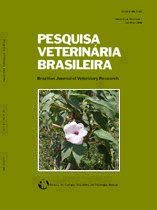 |
|
|
|
Year 2012 - Volume 32, Number 1
|

|
Outbreaks of salinomycin toxicosis in Chinchillas (Chinchilla lanigera), 32(1):43-48
|
ABSTRACT.- Lucena R.B., Fighera R.A., Tessele B., Giaretta P.R. & Barros C.S.L. 2012. [Outbreaks of salinomycin toxicosis in Chinchillas (Chinchilla lanigera).] Surtos de intoxicação por salinomicina em chinchilas (Chinchilla lanigera). Pesquisa Veterinária Brasileira 32(1):43-48. Departamento de Patologia, Universidade Federal de Santa Maria, Camobi, Santa Maria, RS 97105-900, Brazil. E-mail: claudioslbarros@uol.com.br
Four outbreaks of ionophore toxicosis are described in chinchillas from four commercial farms located in three municipalities in the state of Rio Grande do Sul, southern Brazil. Approximately 2,000 chinchillas showed decrease in food intake one week after start ingesting a ration containing 37 ppm of salinomycin. Four hundred and twenty seven chinchillas showed apathy. Of those 277 develop sternal and lateral recumbence, dyspnea and coma followed by death. First deaths occurred eight days after the start on the salinomycin containing ration; clinical course was 2-5 days. Serum chemistry carried out in four chinchillas revealed increased levels of alanine transaminase, aspartate transaminase, alkaline phosphatase, creatinenin kinase, glucose, triglicerids and total cholesterol. Forty five affected chinchillas were necropsied; consistent necropsy findings were marked hepatic lipidosis; additionally twelve pregnant chinchillas had dead decomposing fetuses. Microscopically skeletal muscles had multifocally swollen hypereosinophilic myofibers with loss of cross striations. In those chinchillas that survived longer than a few days, microscopic features in the skeletal muscle included segmental fragmentation of dead fibers (floccular necrosis) and myofiber regeneration. Marked fatty degeneration was observed in the livers of all affected chinchillas. No microscopic changes were observed in other organs. Chemical analysis in the feed consumed by the chinchillas did not detect aflatoxins or pesticides residues; bacterial culture performed in samples of liver and intestinal contents from necropsied chinchillas yielded no significant bacterial growth. Analysis by thin layer chromatography performed in the ration consumed by the chinchillas detected 37 ppm of salinomycin. The suspected ration was fed to 12 chinchillas three of which (25%) died with similar lesions to those observed in the natural cases. The diagnosis of salinomycin toxicosis was based in the epidemiology, histology of the lesions, on the detection of significant amounts of salinomycin in the ration used to feed the chinchillas in the four involved farms and on the reproduction of disease by feeding the suspected ration to susceptible chinchillas. |
| |
|
|
| |
|
 |